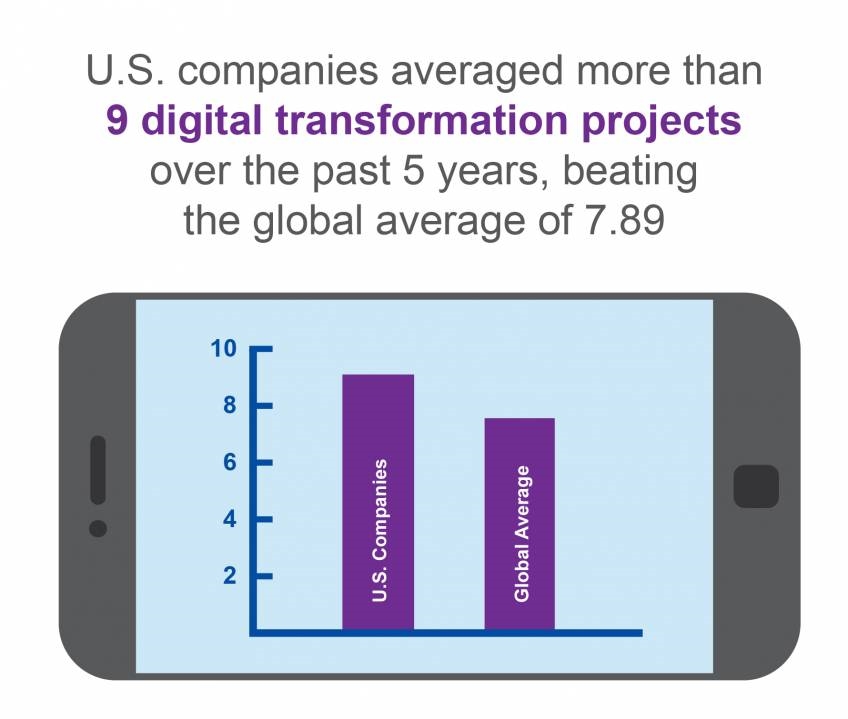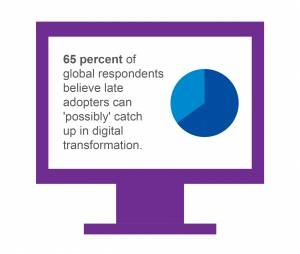Will Companies Embrace Digital Transformation?
Will Companies Embrace Digital Transformation?

Global spending on digital transformation — or the digitalization of business practices, data, and products within organizations — is projected to reach $ 2.3 billion by 2023. With the future seeming ambiguous, will companies embrace digital transformation?
What should companies reimagine in this transformative phase now to be relevant later?
In a survey of more than 1,000 executives spanning the globe, Wipro found that digital transformation looks markedly different for each company wanting to embrace an increasingly ambiguous future.
While companies globally have spurred an average of eight digital transformation projects over the past five years, U.S. companies lead the pack, with a mean of just over nine projects.
Those in Canada and the European Union fall closely behind, with Mexican and Brazilian companies claiming the lowest average of digital transformation projects overall.
No matter the country, roughly equal numbers of respondents note budget, people, technology, and processes as the biggest stumbling blocks for their firms’ initiatives.

The future is still for the taking — even for slower firms.
A significant swath of respondents — 65% — believe companies late to the digital transformation game could still overcome competitors. The majority of companies say their organizations’ transformation efforts are either “somewhat” or “very” successful.
Likewise, the vast majority of these executives believe their firms are aligned on what digital transformation means.

Staying Ahead of Turbulence
As the new decade begins, executives across industries also see two significant yet contradictory trends on the horizon. First, there’s nervous uncertainty: A recent survey of Fortune 500 companies showed that the share of CEOs who felt the global economy would grow in 2020 fell from 40% to 17%.
Ninety-two percent of those surveyed also predict a recession to happen sometime in the early 2020s.
Another CEO survey by EY found that 82% of these leaders expect their businesses to be disrupted by artificial intelligence in the next few years and that 85% consider themselves “AI optimists.”
There is an opportunity (or perhaps a mandate) in the coming years for positive transformation spurred mainly by new technology.
What’s the common thread between these two visions in the near future? Assurance that what lies ahead will bear little resemblance to the past.
Our global economy is on the brink of sweeping change, and the fundamental role of businesses — no matter the industry — will certainly shift. In our post-digital world, transformation initiatives should certainly keep this in mind.
Technology’s Ripple Effect
Although the public feeling ambivalent at best about the role of AI-driven automation (and similar technologies) will play in the future, its involvement in the emerging global economy is inevitable.
AI grows increasingly relevant as business becomes increasingly ambiguous.
The AI process is important chiefly when a particular process, dataset, or task requires a level of efficiency and insight that’s essentially impossible for a human to deliver.
Even today, companies must constantly ask themselves when a task is best suited for a human, a machine, or an employee assisted by a machine’s capabilities.
Thanks to emerging technologies, these questions will only become more complex.
The ever-accelerating pace of change should be the first risk factor on the minds of CEOs (if you’re unconvinced, simply read Constellation Research founder Ray Wang’s thoughts on digital duopolies).
This means another important shift is now underway: Advanced technologies will spark exponentially more transformative, wide-reaching change as the rate of adoption increases.
We’re seeing a technology domino effect.
As smaller, more specific use cases go into practice, they simultaneously make bigger, more ambiguous applications possible.
Those applications might even span across industries, reshaping verticals that traditionally haven’t been integrated with the tech sector itself. Not being integrated with the tech sector means boardrooms should consider whether their internal transformation actually matches the level of external transformation happening.
Remember: Companies that have trouble achieving success in the digital age often do so because their internal transformations don’t cater to the changes at the outside or customer levels.
Mass adoption of 5G
Our case in point here is the impending mass adoption of 5G. Whereas 5G’s predecessors have primarily created value across the telecommunications vertical, this change is different. The telecommunications industry must still make large capital expenditures and hardware upgrades to create nationwide networks for their customers.
But because 5G relies heavily on software-defined networks, it can also be used to create extremely fast and agile local networks that are more easily implemented in other verticals (manufacturing is just one great example).
Speed of a 5G Network
The speed of a 5G network also allows players to implement more advanced AI and machine learning applications in these fields.
For example, if a manufacturer couples a machine learning algorithm designed to direct workload with real-time 5G data from automated equipment, that company could create a self-sustaining manufacturing process.
A self-sustaining manufacturing process would clarify at least one element — the workload machines can and should handle when producing high-quality equipment at the volume consumers demand — without any additional human input.
Kick-Starting a Lateral Shift
5G is one notable example that will likely come to pass, but the larger principle at play extends to many kinds of advanced technologies. The value from implementing these solutions won’t simply be vertical — it’ll also extend horizontally.
Technology will be transformational.
They are transformational, not just because of the tasks they accomplish, but also because of the possibilities it unlocks and the convergences it creates.
The customer journey.
We’re seeing this at play on the consumer side, too. As customer journeys grow more integrated, the way businesses map them out is also becoming horizontally integrated. Perhaps a customer discovers a product using an e-commerce platform developed by a consumer business.
That company uses manufacturing tools created by a technology firm, which also relies on a 5G network powered by a telecommunications provider. There’s more ambiguity here, which necessitates more technology.
People often ask whether we’re in the business of building products or providing services.
To truly prepare for the future economy, though, the answer is neither of those things: In reality, we’re in the business of providing platforms that are fundamentally scalable and agile enough to achieve new possibilities. Products and services will become experiences and outcomes.
We can’t talk about a single discipline or value stream anymore — everything is mixed and matched.
The future economy will be more complicated and ambiguous, but it definitely won’t lack opportunities — it’s sure to create exponentially better outcomes across an array of different industries.
Success, then, will depend on a company’s ability to see important moments approaching and take the correct course of action. Are you ready to embrace these changes?
The post Will Companies Embrace Digital Transformation? appeared first on ReadWrite.
(41)

